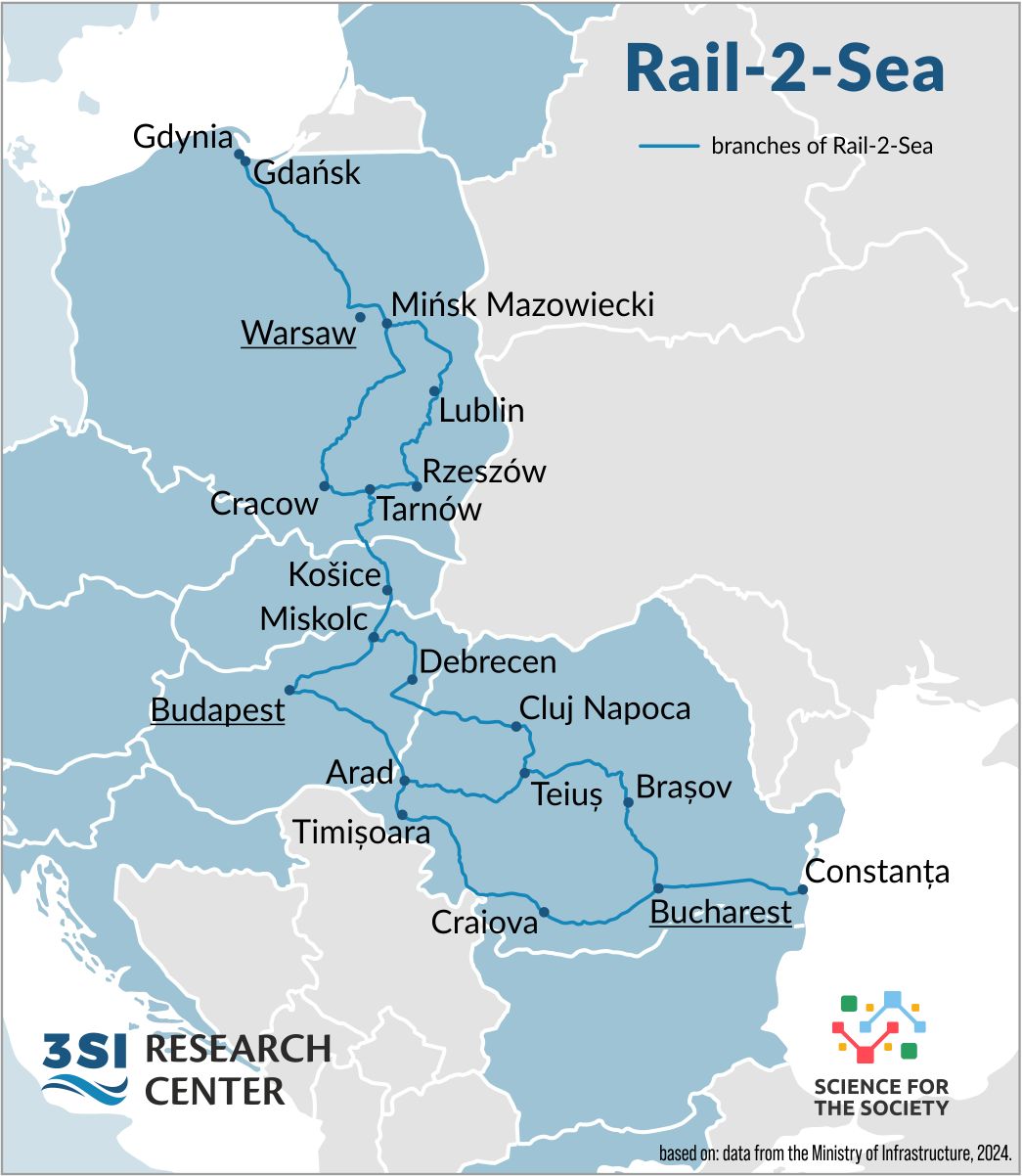Rail-2-Sea Project Overview
The following information was compiled exclusively based on information regarding Rail-2-Sea available on the official website of the Three Seas Initiative
Summary: Rail-2-Sea is a critical railway project aimed at modernizing and developing the railway line between the port of Gdansk (Poland) and the port of Constanța (Romania), crossing Poland, Slovakia, Hungary, and Romania. The project is part of the TEN-T core rail network and is financed through various EU funding mechanisms.
Project Details:
- Branches and Key Sections:
- Northern Branch A: Episcopia Bihor – Cluj Napoca – Campia Turzii – Teius – Coslariu – Brasov – Predeal – Ploiesti – Bucharest – Fetesti – Constanta
- Northern Branch B: Arad – Simeria – Coslariu – Sighisoara – Brasov – Predeal – Ploiesti – Bucharest – Fetesti – Constanta
- Northern Branch C: Valea lui Mihai – Oradea – Cluj Napoca – Dej – Beclean – Ilva Mica – Vatra Dornei – Campulung Moldovenesc – Gura Humorului – Suceava – Pascani – Bacau – Focsani – Buzau – Fetesti – Constanta
- Southern Branch: Arad – Timisoara – Caransebes – Craiova – Bucharest – Fetesti – Constanta
- Completion Date: Ongoing
- Budget: €16.68 billion (51.57% secured)
Significance: Rail-2-Sea is essential for enhancing transport infrastructure, boosting economic growth, and improving connectivity across Central and Eastern Europe. It aligns with EU priorities on sustainability and regional development.
Infrastructure and Goals:
- Route: Connects key industrial and port areas from Poland to Romania.
- Implementation: Focuses on modernizing existing infrastructure, integrating Intelligent Transport Systems (ITS), and enhancing intermodal terminals.
- Key Goals:
- Achieve high engineering standards for infrastructure.
- Implement innovative ITS solutions.
- Enhance safety and compliance with EU standards.
- Develop alternative fuel-driven corridors with real-time data exchange.
- Provide real-time information on the availability of refueling stations and EV charging points.
- Ensure safe and secure parking places, roadwork updates, real-time traffic information, and weather conditions.
Key Entities:
- Implementing Entity in Romania: National Railways Company CFR-SA.
- Promoter/Beneficiary: Ministry of Transport and Communications.
Impact: Rail-2-Sea will significantly improve travel efficiency, reduce transit times, and support environmental sustainability. The project will enhance the region’s ability to support rail freight and passenger transport, contributing to economic growth and regional connectivity.
Calendar of Implementation:
- 2021-2024 (Design Phase): Ongoing feasibility studies, technical designs, and public tenders.
- 2021-2024 (Construction Phase): Execution of works on multiple sections, with various completion dates.
- 2016-2019 (Completed): Key sections such as Western border – Curtici – Arad, Simeria – Sighisoara, Predeal – Bucharest, and Bucharest – Constanta have been completed.
Funding Sources:
- CEF
- National funding
- Other EU funding
The project receives funding from the EU Cohesion Fund allocated through the Large Infrastructure Operational Programme, CEF-Transport Programme, and the state budget of Romania.
Coherence with EU Priorities and Policies:
- Directive 2016/797/EC: Interoperability of the rail system within the Community.
- Regulation (EU) No. 1315/2013: Guidelines for developing the trans-European transport network.
- Technical Specifications for Interoperability: Compliance with EU rail networks’ specifications and legislation.
Innovative, Safe, and Sustainable Technologies:
- Technologies: Upgrades to existing infrastructure, digital infrastructure development, and implementation of Smart City solutions.
- Focus: Safety, efficiency, and sustainability.
Relevance for the Region:
- Economic Potential: Connects major industrial centers with Constanta Port.
- Digital Infrastructure: Supports 5G and Smart City technologies.
- Transit Efficiency: Reduces transit times and optimizes transport.
Map project: Jędrzej Błaszczak
Graphics: Marcin Wereszczyński
